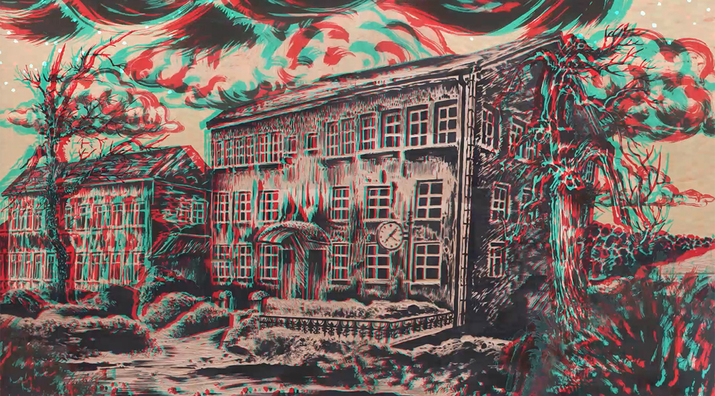
R
E
V N
E
X
T
Installation view of SUN XUN’s Time Spy at Times Square, New York. Photo by Charles Roussel. Courtesy Sean Kelly, New York.
In a crowded space, the sensation of time passing can expand and contract wildly. Tense amongst the clamor, the beat of one’s heart may begin to race, distorting the natural syncopation that dictates anything from the rate of one’s breath to the pace that one walks. Seconds, minutes, hours bleed into one another. As the mind becomes a dizzying array of vectors, so too does its relation to space and time.
In the heart of New York’s Times Square, one can easily become lost among the crisscrossing of streets between the canyon-like structures. The ever-constant rivers of advertising have gone on to inspire similar, now seemingly ubiquitous urban centers—Shanghai, Tokyo, Hong Kong, Bangkok, London—adding to the swirl of the moment and creating a vortex that temporarily ensnares anyone wandering through its tidal pull. Both trapped in time and highly reflective of it, the facades are emblazoned with the ephemeral gesture of advertisement. Equally a sign of the times, the tallest of the towers, and most visible at the center of the whole experience, is a massive LED screen built for the Chinese media giant, Xinhua.
Juxtaposed, or perhaps just part of this unrelenting maelstrom, appearing for a fleeting moment, is a three-minute video that shows only once every night, from 11:57 p.m. to midnight, by Chinese artist Sun Xun. Titled Time Spy, the work is a cut-down and curated segment from Sun’s multi-media installation Reconstruction of the Universe (2016), originally featured at Art Basel Miami Beach.
Installation view of SUN XUN’s Time Spy at Times Square, New York. Photo by Charles Roussel. Courtesy Sean Kelly, New York.
The video, crafted in Sun’s unique style of animation created through the painstaking process of producing hundreds and thousands of woodcut images, stands in stark contrast to the saturated, hyperrealism of the typical assortment of Times Square ads. Detailing a kaleidoscope of events and objects—including factory work, Vladimir Tatlin’s Monument to the Third International, flying winged violins, swirling moons and spinning cogs—the work is a frenetic meditation on themes of labor, industry and time’s expanse, depicted in the aesthetic of early-20th-century artists like Li Hua or Jiang Feng. Expressed in 3D—with free glasses being distributed to passersby three nights a week—the images seem to further peel out from their back-lit moorings, colliding with one another as they shift from their many screens. As such, the overall effect merges with the artist’s intention: in Time Spy, the emphasis is placed on how physical and temporal boundaries become murky. In such a space as Times Square, the once claustrophobic environment, among the crush of the crowd, expands, contracts, and undulates with each frame, alluding to limitless time and ever-expansive space.
Sun Xun’s work is not new to New York. Featured prominently in the Solomon R. Guggenheim Museum’s 2016–17 exhibition “Tales of Our Time,” Sun’s Mythological Time (2016) dealt with similar themes of the passing of time, employing a range of visual references from ancient Chinese and Greco-Roman literature to images from the modern period and science fiction. In a similar fashion to Time Spy, Mythological Time flashes from one moment to the next at a staccato pace, broken by explosions, screen flares, lurching beasts, and rolling machines. The effect, as with his current work, is to offer an alternative narrative, one that does not hinge on linearity but on the constant evolution of energy through time. Both rely on the dislodging of the expected and its replacement by something more nebulous. In the case of Time Spy, it is that a space once occupied by ribbons of advertising is extricated by the chaotic and brief burst of art. The outcome is a sensation of awe and anarchy, removing, albeit momentarily, the overt underpinnings of a consumerist dialog.
Just as contemporary art made its debut on the big screens of Times Square in 1982 with the series “Messages to the Public,” organized by artist Jane Dickson and featuring the works of the likes of Keith Haring, Jenny Holzer and David Hammons, Sun Xun’s Time Spy creates a foil to the commercial propaganda that regularly occupies the vast public space. While the temporary replacement of the world’s most expensive ad space with art may reflect the further commodification of art, for one brief moment these works become part of the spectacle, offering both a “cultured” respite from the cacophony of commerce to an anticipating art crowd, and adding to the wild disorientation of those who do not expect it.
Sun Xun’s Time Spy is shown every night at Times Square, New York, until July 31, 2017.
To read more of ArtAsiaPacific’s articles, visit our Digital Library.






